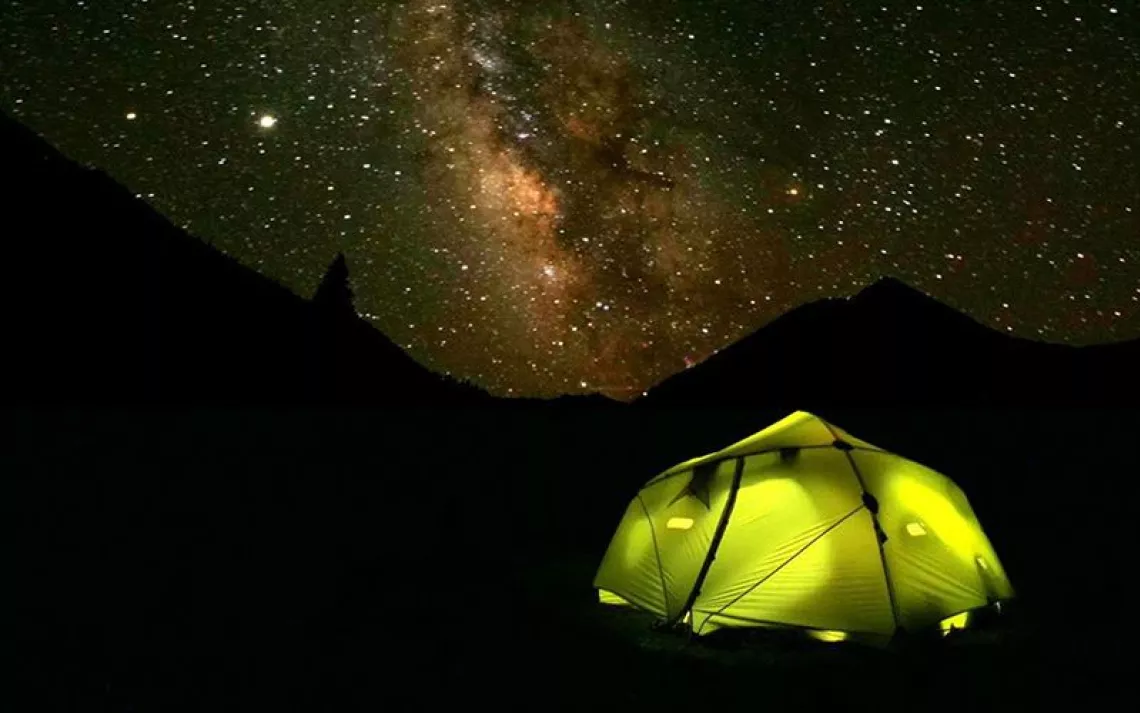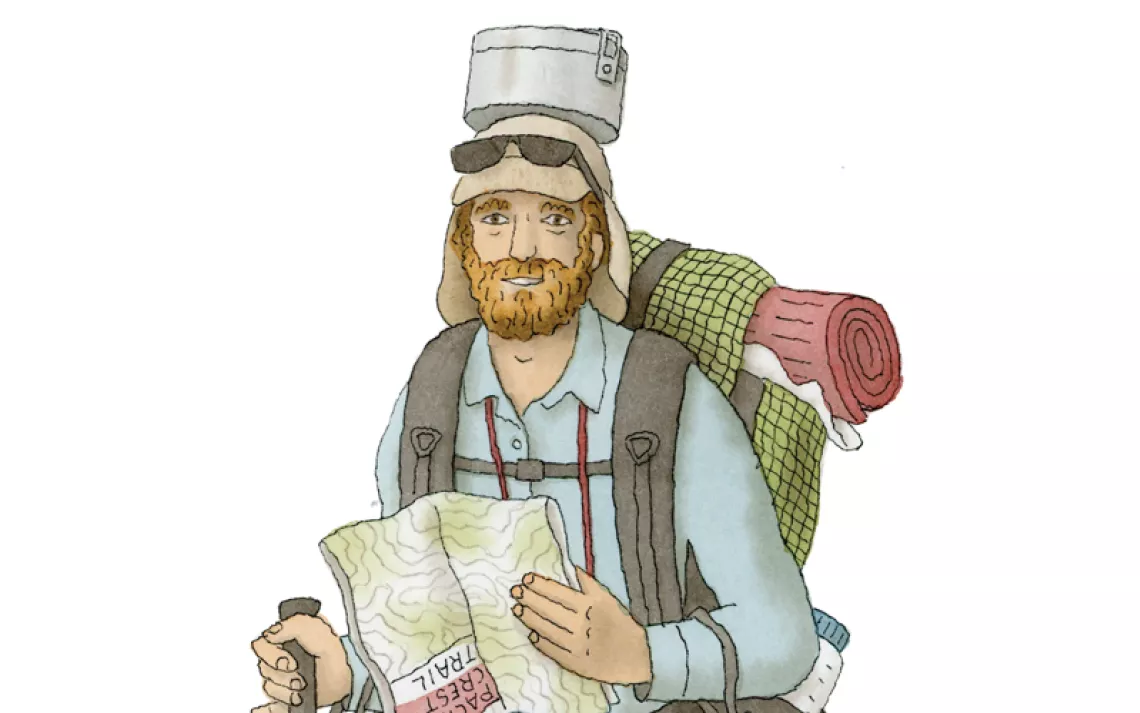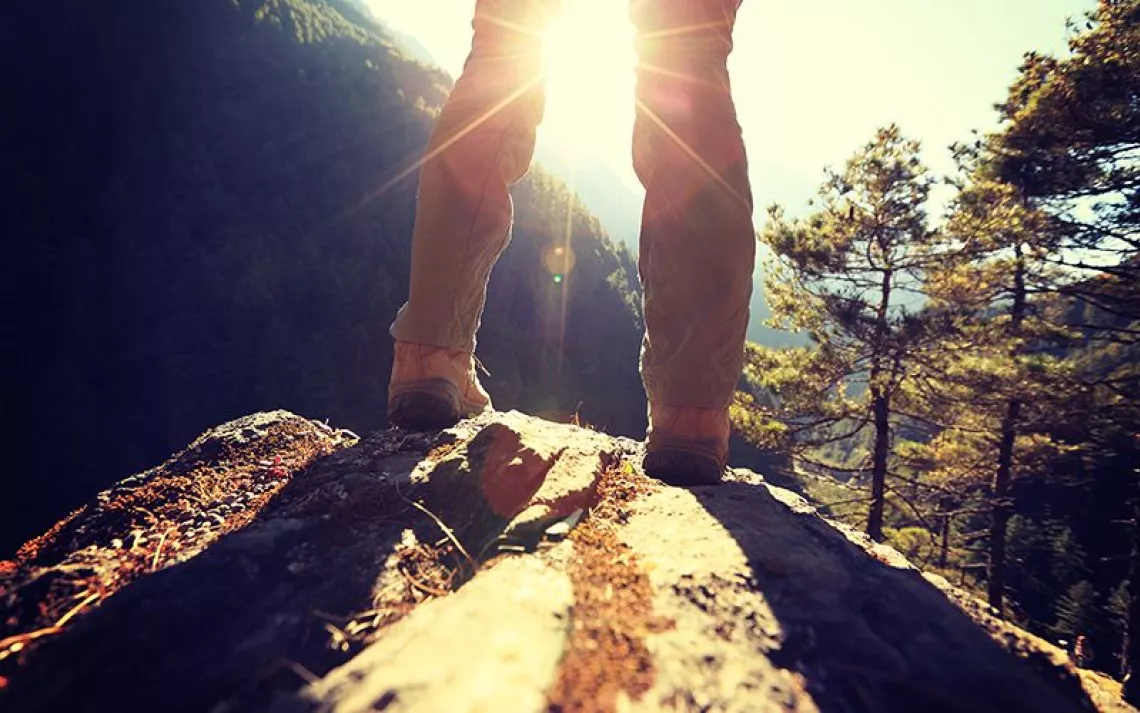A Woman and Dog on the Lost Coast
Backpacking with a canine companion has its ups and downs

Photos courtesy of Katie O'Reilly and Mick O'Reilly
The tiny mountain roads twisted through dense redwood forest, bringing the cobalt sliver of Pacific in and out of focus. On my lap shook all 55 pounds of my three-year-old pitbull-vizsla mix. Considering Maeve was rescued from a basket dumped beside a rural highway, my dog’s nervy mode of road travel was somewhat and understandably typical. But navigating the relentlessly rugged roller coaster that is Northern California’s King Canyon Wilderness had her on the verge of car-sickness, too. I lifted a soft, floppy ear and whispered, “Don’t worry, girl, we’re gonna go for a big walk.” At the sound of her favorite word, Maeve gave me a big, queasy smile. I couldn’t wait to get out of the zigzagging shuttle and onto the Lost Coast, where she, I, and two (human) friends would spend the next three days trekking sandy trails at a decidedly non-nauseating pace.
From Mexico and up the bulk of the way through Oregon, Highway 1 hugs the Pacific coastline. Here in Northern California’s Mendocino and Humboldt Counties, however, a stretch of roadless coastal wilderness unfolds between the teeny black-sand beach communities of Rockport and Ferndale. The topography is so forbidding that California’s highway engineers quite literally ran for the hills, rerouting the iconic coastal highway inland, away from the region’s foreboding coastal cliffs and dark forests. The Lost Coast without question ranks among the most spectacular stretches of a state renowned for the beauty of its shoreline. But unlike rival landscapes in Big Sur or Malibu, there are no mansions tucked into these cliffs, no traffic jams.
The previous summer, I’d trekked its northern half, which is the 25-mile stretch most hikers refer to when they talk of “doing the Lost Coast.” The steady roar of surf, majestic vistas, and antics of the route's vivacious resident elephant seals had left me desperate to get back—as had the opportunity to meet a couple of cool dogs out there in the canine-friendly and BLM-managed King’s Range Conservation Area.

Few things make me happier than seeing Maeve savor a trail. On regular walks around our home in Oakland, she’s a fearful, sensitive thing, wary of buses and loud passersby. Take her up into the East Bay’s hills, though, and melancholic Maeve grows a jack-‘o-lantern-portioned smile and morphs into a borderline overconfident animal. Her coltish legs and long, lithe body become a blur as she flies up the steepest of hills, only to repeatedly zip down and back, waiting for me to summit.
Leading up to our Lost Coast jag, we’d spent plenty of time trekking and trail-running together, covering 17 miles one warm summer day. Most hikers park at the trail’s southern end—Black Sands Beach in Shelter Cove, California—hitch a shuttle to its northern terminus of Mattole Beach, and spend three to five days walking back to their cars. Despite all our hiking, the moment when we hopped out of our shuttle at Mattole marked Maeve’s first foray into backpacking.
As we trekked toward the smudged outline of the Shelter Cove lighthouse, Maeve was smiling and heeling, looking peppy and purposeful in her pack—not to mention adorable. Dogs, I told myself, were meant for backpacking.
But then we hit our first patch of rocks, which is when I forced Maeve into her boots. Much of this hike involves jumping from boulder to boulder, which can bruise dogs’ nails to the point of bleeding. Plus, all that Lost Coast sand functions like sandpaper, rubbing paws’ pads, and the skin between them, raw. On Lost Coast websites, King Wilderness rangers emphasize the importance of bringing boots for dogs. Not that Maeve cared a whole lot for ranger advice—every chance she got, she burrowed into the sand and used her teeth to peel off the boots.
This all ate up time, which presents a real problem on the Lost Coast. Here, the tides dictate a specific—and high-stakes—hiking schedule. Twice per day, stretches of the route vanish altogether beneath the Pacific’s high tide. As I repeatedly pulled the boots’ Velcro ever more tightly around my dog’s ankles, begging and willing her to please keep them strapped to her paws, I tried not to picture the surf rising 20 feet out of the sea and pounding against the cliffs behind us—as the tide schedule in my pocket assured me it would. We badly needed to get beyond the intertidal zones and to a safe campsite.
The BLM doesn’t restrict Lost Coast camping to any specific area, but it encourages backpackers to seek obvious existing campsites, so as to lessen human (and, I suppose, canine) impact. Most of those campsites are tucked back from the beach in narrow valleys carved by lotic streams emptying into the sea. Since the Lost Coast’s permit system allows only about 60 backpackers to attempt its terrain at a time, lucky recipients are treated to a profound sense of solitude. You might see less than a handful of fellow hikers during the day, but come sunset, these sites function as semi-social hubs of trail camaraderie. The first such camp, at Cooksie Creek, is eight miles south of the trailhead. And on the Lost Coast, where a footstep is rarely steady, most backpackers log only about a mile an hour.

Once, when we found ourselves on an empty and relatively smooth (i.e., not rock-strewn) stretch, I let Maeve kick off her boots and scramble freely over boulders and into the surf, were she examined tidepools and scavenged a buoy that had washed ashore from Japan. Her jack-‘o-lantern smile was back. And, the boots helped to mitigate my fast-growing guilt over the decision to subject my best friend to the “type-2 fun” that so appeals to backpackers.
After hours of travel in sand deep enough to bury each step, hikers look upon any patch of firm ground with relief—and about midway through the Lost Coast, gloriously solid stretches of trail wind through the golden coastal meadows of Spanish Flat and Miller Flat. At the latter, Maeve and I silently watched upwards of 20 deer leap and bound their way up from the meadow and into the cliffs with impossible grace. When we reached camp a mile later and I let her off leash, she performed a breathtaking impression of the does’ buoyant ambulation—something I’d never seen her do back home.
As Gordie Spater, founder of Kurgo, the canine gear brand, had informed me before Maeve and I started training for the Lost Coast, the key to a successful backpacking endeavor with your dog is really knowing your dog. Maeve is far from perfect, but I knew I could rely on her being a “Velcro dog": attached, affectionate, and agreeable as they come—so long as whatever she’s doing makes her human happy. Throughout the trip, she dutifully sat at my side whenever our group stopped to filter water or rehydrate pad thai. She followed me across fast-burbling streams that clearly scared her, and allowed herself to be manhandled when we needed to scramble over jagged points of bedrock that protruded into the sea. She never let anyone in our group out of her sight.
Because all of our best friends’ feet were growing increasingly raw, those of us traveling with dogs became fast trail pals. Our rapport mainly consisted of desperate exchanges about various paw-soothing balms, sticks, and sprays. At campsites, we’d visit one another’s tents to swap remedies and pet each others’ tired dogs. I met inspiring canines who’d backpacked for weeks at a time, who carried upwards of 20 pounds on their backs.

After dusk fell, my novice backpacker would snuggle up next to me in our tent. Then, she’d spend the night licking her sand- and salt-water-ravaged paws, keeping us both up. By our third and final day, Maeve was exhibiting a disconcerting degree of exhaustion. Spater had advised me to increase her kibble intake by 25 percent on the trail, but I was having to force the normally ravenous Maeve to consume any food at all. Whenever she’d lie down in the sand, I’d try to manipulate her with her favorite word. “Come on, Maeve, let’s go for a walk!”—an endeavor I feared I’d forever ruined for my active young dog. Rather than feeling victorious and relieved by the sight of the southern trailhead at Black Sands Beach, I was desperate to get away from the uncharted north coast and its hot sand and to return Maeve to the comforts of home.
Fortunately, my mutt proved to be astoundingly resilient. After devouring a scoop of celebratory ice cream in Shelter Cove, she recalled just how much she loves eating. And following a full day of bed rest once we arrived back home, her paws appeared normal again, and she was soon back to her goofy and energetic self.
But I’d learned my lesson.
In packing for a recent move, I pulled her pack out of a closet. At the sight of the still-sandy thing, Maeve’s eyes lit up; her tail became a blur. While I won’t be subjecting her to backpacking again anytime soon, I'm pleased to report that “walk,” even after our three-day-long stroll, most definitely remains my furry best friend’s favorite word.

Follow in the Writer’s Footsteps
Where: The northern half of California’s Lost Coast, which spans the trailheads at Mattole Beach to the north and Black Sands Beach to the south
Getting There: The closest airport is the Arcata/Eureka (ACV) airport in McKinleyville, California. From there, renting a car will get you to Mattole in about three hours. Or, drive 4.5 hours north from the Bay Area, park at Shelter Cove, and through Lost Coast Adventure Tours, book a two-hour, $85 shuttle ride north to Mattole Beach. (You probably won’t want to attempt driving these hazardous roads yourself.)
Where to Stay: You'll likely want to get an early start on your first day of backpacking, which likely means doing some of your traveling from home or airport the day prior. Northern California boasts campgrounds galore, but if you're driving up from the Bay Area and seeking some creature comforts before or after backpacking, Maeve and I recommend the lovely and highly dog-friendly Mendocino Grove glampground in the town of Mendocino (about 2.5 traffic-free hours from Shelter Cove). You can fall asleep to the sounds of the Pacific... but from comfy queen-sized beds in platform tents. (You can also stretch out in on-site yoga classes and shower beneath the redwoods.)
When to Go: Late May to early October. From late October through April, the Lost Coast can see 60+ inches of rain, and many of its streams become difficult to cross.
Permits: King Range Wilderness permits and hard-sided bear canisters are required year-round for overnight camping. Book permits through Recreation.gov, and reserve $5 bear cans through BLM field offices.
What to Wear: For this strenuous trail, rangers recommend low-profile gaiters, trekking poles, sun scarves, sun gloves, and if you’re a dog, of course, boots (Maeve wore Kurgo's Step-n-Strobe Dog Boots).
Eco Tips: The Lost Coast boasts one of the California coast’s only remaining primordial ecosystems. The invasive European beachgrass dominating the West Coast has yet to appear here. Help keep this the case by cleaning your boots and gear before hiking here. Practice LNT principles and know that wildfires pose a risk here in the dry season. Campfires are often prohibited between late spring and fall—check for notices posted at trailheads before firing up.
Survival Tips: It’s imperative to carry a tide schedule for the specific days you’re hiking. Sometimes, Lost Coast–goers get swept out to sea. Signs at Shelter Cove and Mattole remind hikers to “never turn your back on the sea.” As you hike, make a habit of keeping an eye out for the best escape route in the event you’re faced with sudden waves. Keep another eye on the bluffs above for falling rocks. And watch out for rattlesnakes!
Wildlife: Gray whale watching is excellent from December through March. Year-round, you can spot shorebirds, deer, elk, seals, sea lions, sea otters, and more.
 The Magazine of The Sierra Club
The Magazine of The Sierra Club



